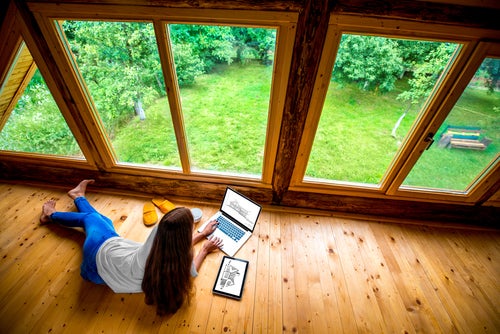
Do you love opening your windows, for a stream of fresh air, whenever possible? Wish you could bottle up the smell of your garden, and bring it into your living room? Feel like ceiling lights just can’t compare to golden rays of sunshine?
If you are a genuine nature lover, you’ve got good reason. Research shows that nature helps reduce stress, boost health, and accelerate healing. Yes, many of us spend a significant portion of our days indoors – but being inside doesn’t have to mean being away from nature. We’re here to help you bring the outdoors in.
Check out these easy ways to incorporate natural elements into your home, so you can enjoy the benefits of nature, whether you’re inside or out.
Incorporate Plants
It’s the obvious choice, but it’s also an easy one. Start by setting potted plants around your home for a lively, natural touch. Small trees, or climbing vines, are a great way to add a vertical pop of green to the space. Terrariums are another fun and eye-catching idea, to help bring nature in your home. As a bonus, plants help to keep your indoor air clean and free from pollutants. If you don’t have an especially green thumb, start with one of these easy-to-care-for houseplants:
- English Ivy
- Pothos
- Spider plant
- Aloe
- Peace Lily
- Jade
Maximize Sunlight
Some homeowners are lucky enough to have big floor-to-ceiling windows that let the sunlight wash in. For those of us without enormous windows, capturing the sunlight and bringing it indoors is a tougher task – but, there are some tricks to brightening any window-lacking room.
Start by painting your walls a bright, reflective color; white and yellow are two good options. Then, accent the space with other reflective colors and surfaces. A cleverly placed mirror near a window can help direct sunlight around the room, and brightly colored accents make the sunlight seem more dramatic.
Bonus tip: Make sure you’re not blocking out the sun with ill-placed curtains or furniture. Open up the space around a window, by installing the curtains beyond the width and height of the window’s frame. Avoid placing big pieces of furniture in front of windows, where they may block some of the sun.
Mimic the Outdoors
When you don’t have a lot of windows to work with, you can bring the view inside with artwork that mimics nature. Paintings of landscapes, or floral-print accent pillows, help give your home that outdoor feel. The closer you can get to actual nature, the better – instead of floral-print paintings on your walls, why not press some flower petals or leaves into a frame, and hang that instead?
Choosing wooden tables and chairs over man-made materials will give a more natural vibe – and, wood elements aren’t limited to furniture. Set up a jewelry tree on your dresser made of an actual tree branch, or design hanging artwork and sculptures with wood from your backyard. Toss a tree stump stool into the den or living room, and use branches (or branch-inspired design) for curtain rods or chandeliers.
If you don’t love the idea of wooden furniture, perhaps try wicker furniture designed for indoor use. Since this furniture is traditionally used on porches and patios, it helps inspire the outdoorsy tone of your home. Likewise, woven baskets – particularly if they’re made from plant stalks – make beautiful and natural-looking storage containers.
Don’t let these quick ideas limit your creativity. You may find inspiration to mimic the outdoors, by incorporating any of these natural elements:
- Acorns
- Leaves
- Pine cones
- Bamboo
- Gourds
The ideas are endless! The next time you’re outside, take a look around, and ask yourself which pieces of nature you can modify to be compatible with your décor.
Add Water Features
Consider setting up a water feature that mimics the sounds of a natural waterfall – for example, a slate water wall is an elegant way to incorporate an indoor waterfall. Water elements, especially flowing water, add a sense of calm and relaxation to a space. They can also contribute to a vibrant and empowering atmosphere, as water is the source of all life. Install a fish tank where you can enjoy the water life, and the sounds of the trickling filter. Or, use tabletop fountains as beautiful centerpieces.
Dress Up Your Décor with Stones
Rocks and stones are can easily give your house a cool, earthy touch of nature. Start by arranging small and medium-sized stones in an opaque vase for a nifty rock terrarium; or, situate pebbles around live potted plants and flowers. If you’re looking for a more permanent solution, consider using stones as a backsplash to your kitchen or bathroom décor.
If you find your particular natural geodes somewhat boring, you don’t have to settle for the rocks in your backyard. Gemstones and agates are beautiful natural elements that easily add a flashy pop of color to a shelf, or mantel. You can even use well-cut agates as coasters that your guests will rave about.
Embrace Your Wild Side
Elements reminiscent of wild animals often provide fun and beautiful ways to bring a sense of nature indoors. Animal-print accents like throw pillows, baskets, and wall art can make cute and subtle touches of the wild – but don’t be afraid to think beyond that. A fur rug adds an intriguing and cozy texture to your hardwood flooring, for a simultaneously wild and soft touch. Decorating your bathrooms with seashells, and other ocean-inspired elements, is a great way to bring the sea life into your home. Keeping pet fish, or hanging shed antlers, bring striking natural animal elements to your indoor space.
Be More Open
It seems like such a simple solution, but it’s often passed over – one of the easiest ways to bring in nature is opening up your doors and windows when it’s nice out! Let the natural breeze run through your home, so you can breathe the outside air, even when you’re attending to indoor tasks. Even simply remembering to open the drapes each morning can make a huge difference in how light and fresh your home feels. If it’s a hot and muggy day, or chilly outside, turn on the ceiling fan to give you a touch of a “man-made” breeze that will make it feel like you’re sitting outside.
With these ideas in mind, you can create a livable indoor space that still allows you be connected to the great outdoors. Which one will you start with, on your journey to redecorating your space with nature? Is there anything you’d like to incorporate into your design, but aren’t sure how?
